2020 Mars Opposition Observations Part 1 (up to 19 September)
THE 2020 MARS OPPOSITION BLOG
September 2020
This is the second update I promised. Here I mention recent satellite observations, some of which were sent to the Section in response to the observers’ challenge posted at the start of the month on the BAA website’s front page. Anthony Wesley (Australia) found the satellites useful for orientating his images on September 14, when he captured both moons. Nick James (Chelmsford, UK) using a 279 mm SCT on September 13 wrote in part on his BAA member page, and in an email: “…This camera is not ideal for the challenge since it is intended for deep-sky images. It has a mechanical shutter and no anti-blooming so there is a strong overflow for bright objects down a column. The pixel size is also relatively large (0″.64/pix). This is the result of a stack of 10 x 1s images (about my shortest possible exposure) processed with a radius 6 median background subtract. Deimos is easy, Phobos more difficult since it is closer to the planet but the astrometry of both is within 0″.2 of the ephemeris positions. The circle in the inset shows the current diameter of Mars at this scale (20″.7 arcsec).” A considerably cropped version of Nick’s image is posted here (limited by an image width of 800 pixels).
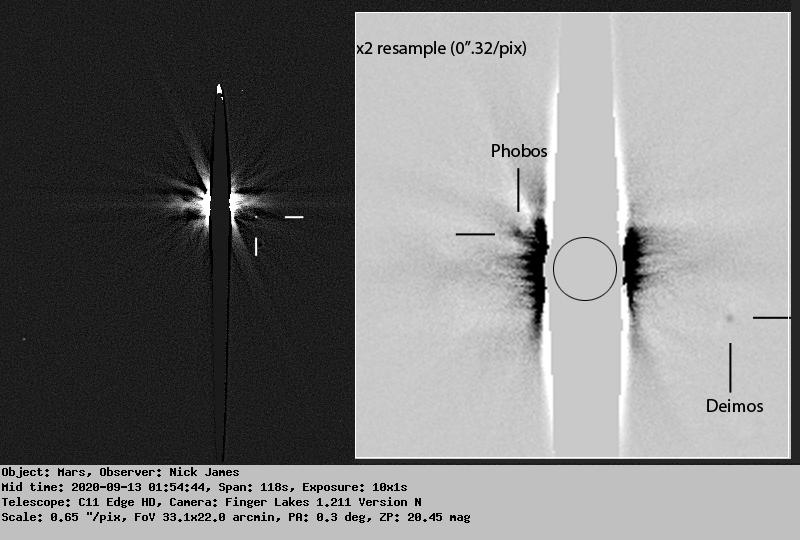
I have not heard very much from visual observers. But Keith Venables (Camberley, Surrey, UK) has reported a successful attempt at the challenge, and his recent email reads: “Interesting challenge! Thanks. I had previously done this while at the Texas Star Party using a 10″ Newtonian…..I remember it was all down to making an occulting strip and having clean optics. I tried it again last night….. First a 102mm Vixen fluorite refractor, f/9. Using a 24.5mm super Plossl with a x4 power mate………..magnification x150. A strip of aluminium foil (2 mm wide) had been stretched across the eyepiece focal plane. At 00:20 UT on 15/9/2020 I could glimpse Deimos using averted vision. Deimos separation 57″ (centre to centre). Couldn’t see Phobos which was at 30″. Second an 18″ f/4.5 Dobsonian….. magnification of about x336. Despite annoying diffraction spikes from the spider, both moons clearly visible at 00:30 UT, so almost identical separations as above.” Keith did not make a sketch. I have not searched the literature, but I think the smallest telescope with which I had previously read reports of sightings had an aperture of 6 inch (152 mm). Keith’s Vixen is an apochromat and, as he writes, clean optics and an occulting bar are generally essential. Has anyone looked into the literature on the question of a minimum aperture?
I have been trying to update this blog for the last week, but the daily receipt and filing of the many images and sketches received, in addition to making my own observations, has been very time-consuming. So I will make three mini-updates instead of one big one. This is the first, which will deal with everything except white clouds and terminator projections and observations of the martian satellites (of which several have been made). The next two updates will follow shortly.
The S. polar cap shows several irregularities and a prominent indentation or rift in the longitude of Solis Lacus, as shown for example by Peter Edwards (UK) on September 9 and John Sussenbach (Houten, Netherlands) on September 14. Observers continue to follow the demise of the outlier Novus Mons, shown here as a tiny bright fragment by Mike Hood (Kathleen, Georgia, USA) on September 3. By September 16 it was barely seen as a pale halftone marking, suggesting that all the ice had evaporated to leave the bare ground merely marking its location, an effect well seen in 2003.
Dust activity has been minimal, with a few hints of very small scale storms near the SPC. The albedo markings around Oxia Palus, which have been changeable since the 2018 global dust storm, have still not returned to their ‘normal’ configuration. Although Margaritifer Sinus looks more normal, there remains the small albedo feature joining Oxia Palus to the SE corner of Mare Acidalium/Niliacus Lacus. This longitude is recognised as a good test of resolution, and images by Anthony Wesley (Rubyvale, Queensland, Australia) and Kenkichi Yunoki (SakaiCity, Osaka, Japan) on September 9-10 posted here show (in addition to the above albedo features) many tiny dark spots within the larger craters immediately north of Meridiani Sinus. Wesley’s image shows the contrast level close to natural, while Yunoki’s is considerably enhanced.
The Solis Lacus region was recently well placed to UK observers and the Director made detailed drawings on several nights. Phasis and Gallinaria Silva are still conspicuous features following Solis Lacus, while Melas Lacus is much larger and darker than Noctis Lacus.
We now have 80 active contributors! any thanks are due to all those who have sent in their work. My job will be made a lot easier if regular observers can (a) put south uppermost and (b) label images in the format 2020-09-17-2359UT-RJM. And if you insist on north uppermost, please send the image as a jpeg file so that it is quick for me to amend it!
September 3
We have reached a total of 70 active contributors. The martian atmosphere is quite clear, with exceptions to be noted below. The SPC fragment Novus Mons has now reached a very tiny size. A seasonal rift near longitude 90 degrees accounts for the indent recorded in F.J.Melillo’s August 25 image, shown here, and will cause the asymmetry of the cap to increase with time.
At this season, when dust storms have been occurring in the S. hemisphere, and when the phase defect is still strong, there is sometimes evidence for terminator projections. In such cases the Sun illuminates the tops of high dust clouds, which thereby project beyond the geometric (sunset) terminator. In the last weeks there has been some evidence of this effect just north of the SPC, recorded – for example – by the Japanese observers R.Konnai (August 24, CM = 195 deg.) and T.Kumamori (August 18, CM = 210 deg.). Witness their images posted here, which obviously show the same affected region of the planet. When Konnai observed visually he found the relevant area somewhat yellowish.
The Director had superb views of the markings around the longitude of Mare Cimmerium and Tyrrhenum on September 1, and several other observers had equally fine sightings that day. To my eye the surroundings of Elysium remain faint, and Nodus Alcyonius also was not very dark. White clouds are still a rarity but the N. polar hood is slightly stronger, and I thought the limb brightening a little enhanced following the Syrtis Major as it moved off the limb: hints of faint a.m. cloud. Hellas looked normal, rather dull with faint interior markings.
A second short interim report will be published in the October Journal, and a challenge to observe the martian moons has recently been uploaded to the BAA website front page
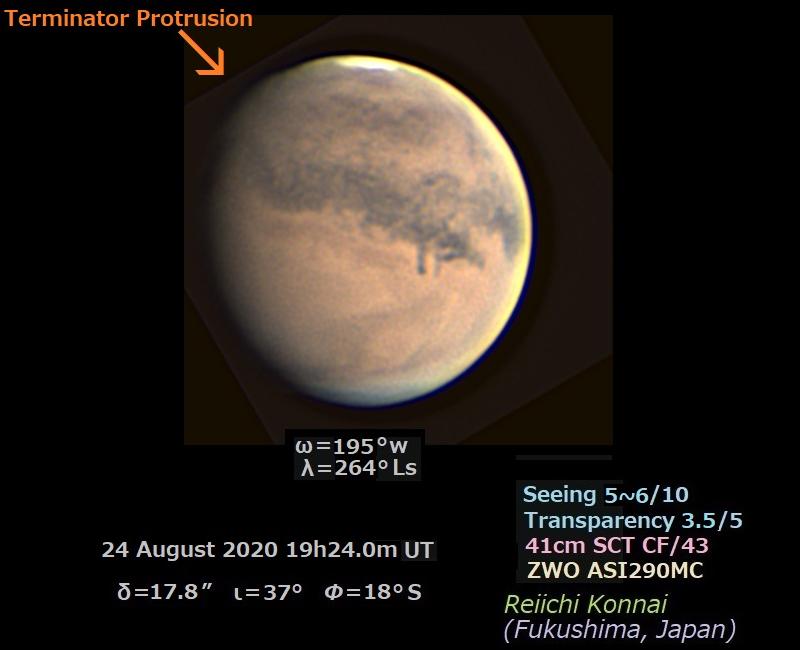
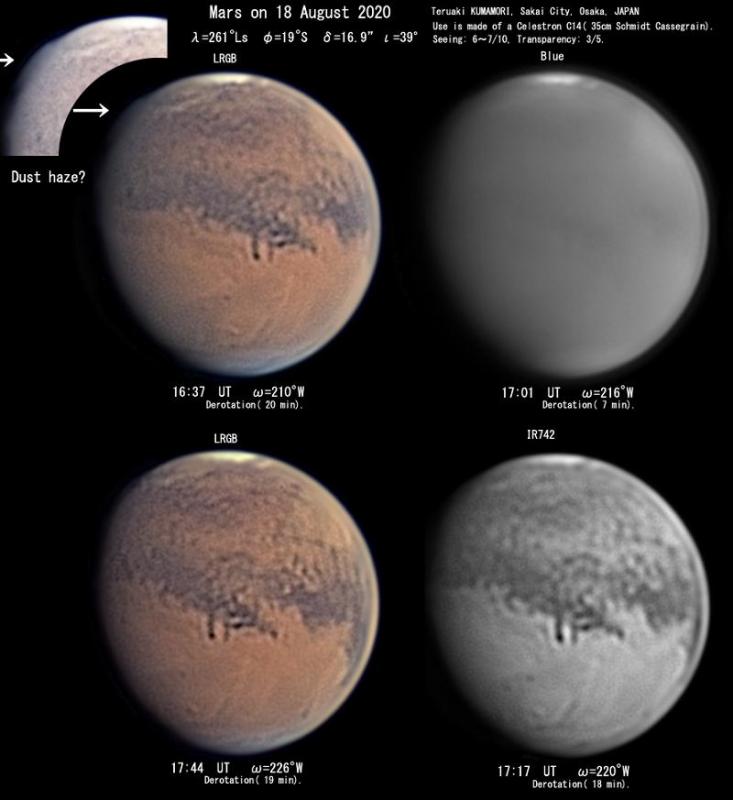
August 2020
August 18th
We welcome many more observers since the last update, many of them old friends, and having achieved a total of 64 observers two months before opposition is surely a good sign for the Section’s activity. Vincenzo della Vecchia has sent us his images of August 2 and draws attention to the return of the seasonal orographic cloud at Arsia Mons. Arsia is interesting in that it is the southernmost of the Tharsis Montes, and its banner cloud has different seasonal limits to those at Ascraeus and Pavonis Mons. In 2005 the Arsia cloud became visible at Ls = 254 degrees (2005 July 22), for instance, while on 2020 August 2, Ls was equal to 250 degrees. Its seasonal appearances are modified by dust activity. At present, you must catch the volcano very close to the evening terminator in order to see this cloud.
The SPC has been recessing at its maximum rate, and observers have made good drawings and images of the various rifts and outliers. Makoto Adachi sketched several details on July 31, for instance. Timing the final breakup of Novus Mons will be important. At present it is already fragmented into two parts.
Associated with the fast SPC recession have been a number of very small local polar dust storms, visible as yellowish streaks or patches at the cap edge. These initially changeable streaks give rise to static fallout, and a full account is reserved for later. The phenomena have been well seen during the last few weeks, and we display some images here by MacNeill (July 31), Clyde Foster (August 1), John Sussenbach (August 2), David Arditti (August 7) and a drawing by Chris Nuttall (July 31).
The consequence of the polar cap’s decline has been the rise in white clouds, noted above, and the enhanced prominence of the N. polar hood.
Solis Lacus remains large and dark, as drawn by Paul Abel on August 13. The Director had excellent views of it on August 12, when the surrounding desert was quite dusky. To my eye, Aurorae Sinus and Gallinaria Silva (the dark patch at the N. end of Phasis) remain some of the darkest areas around these longitudes.
Many observers are now turning out splendid high resolution images and we can only give a few examples here. Some observers manage to get up in the small hours every day, and I will highlight the achievement of Ed Grafton who in addition to providing us with images since early July has obtained results on every single morning from August 7-16, so far. We upload his images for the first eight of these dates here.
We will showcase other high resolution work in the next update.
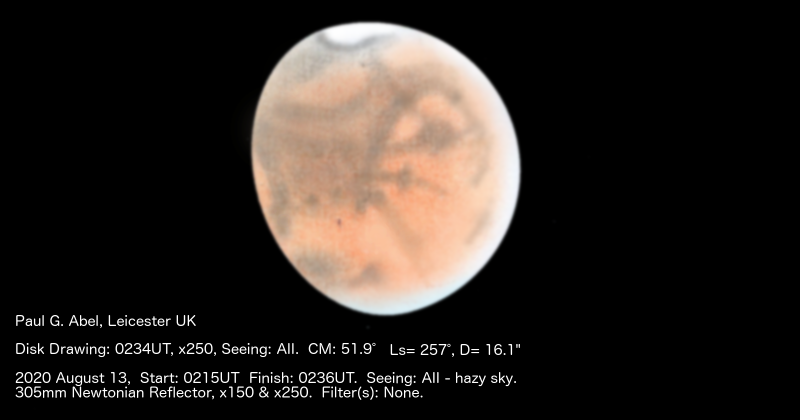
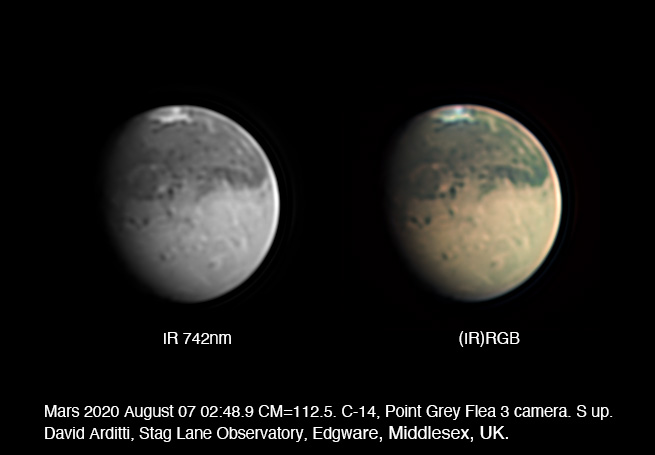
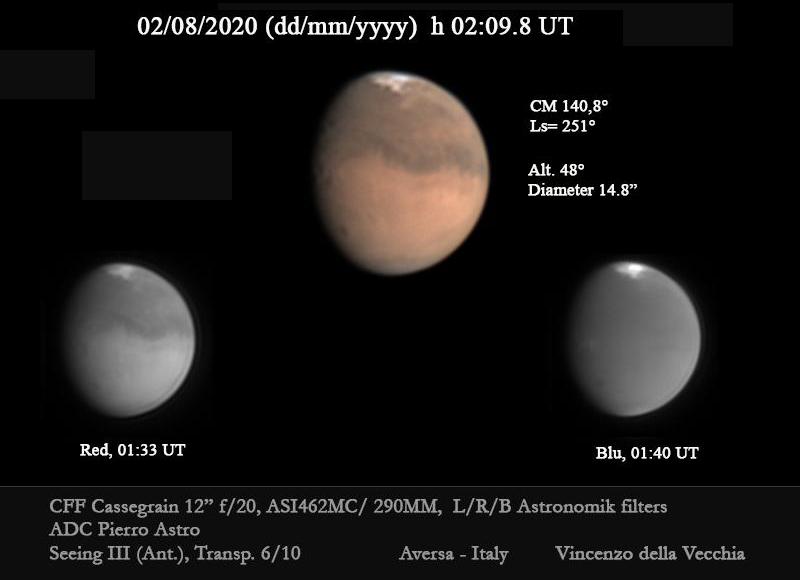
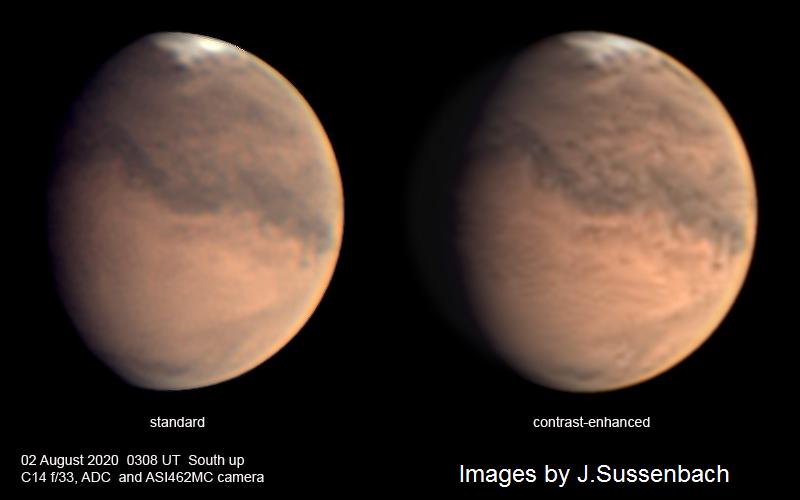
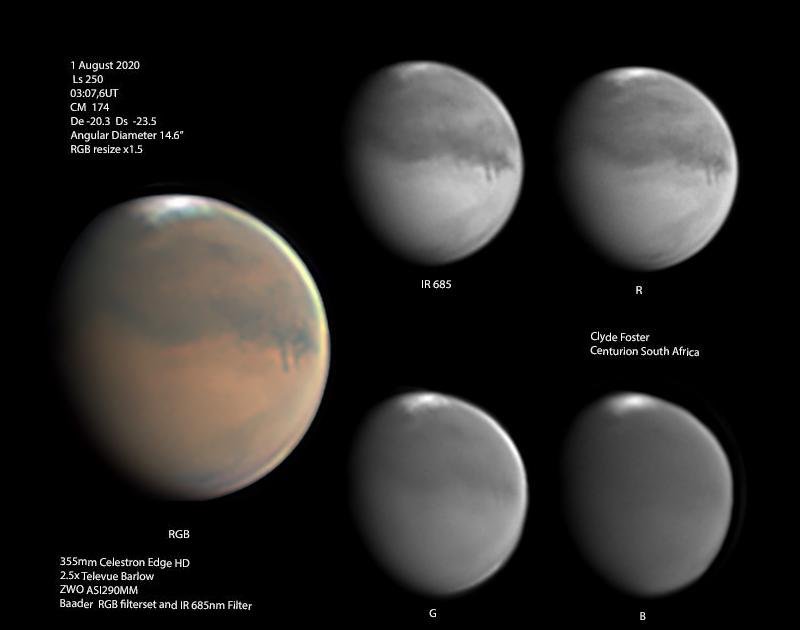
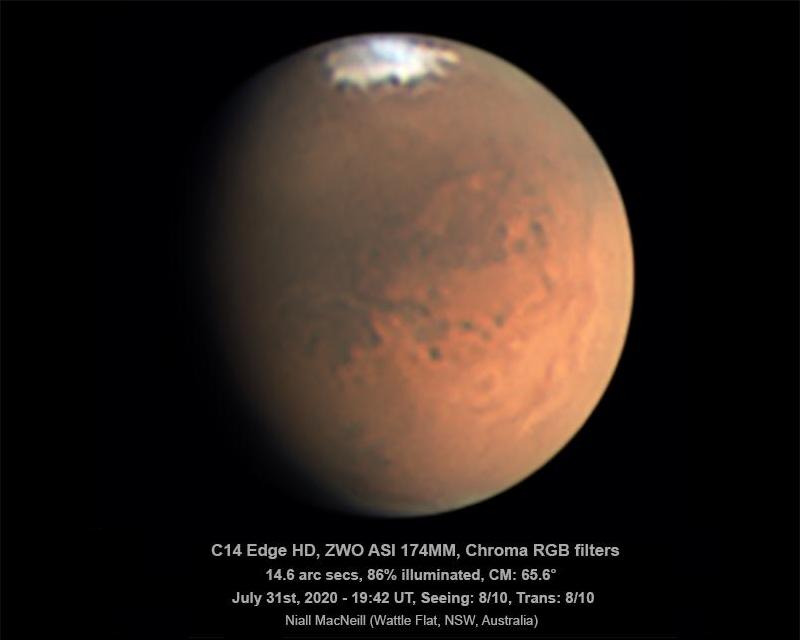
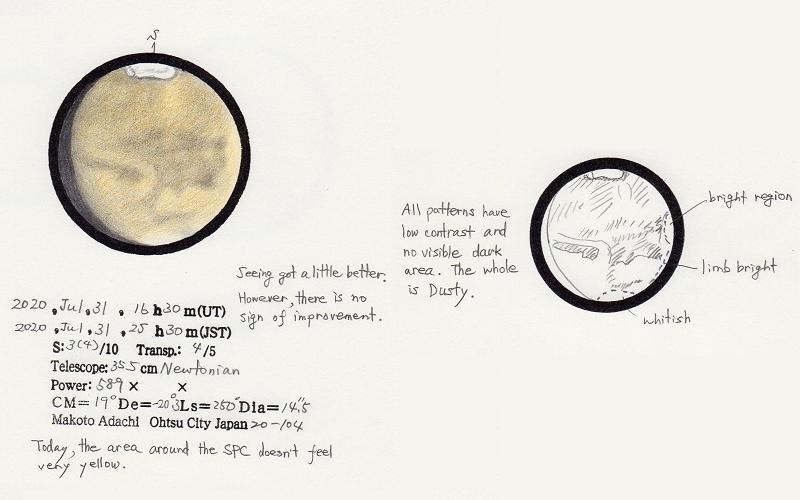
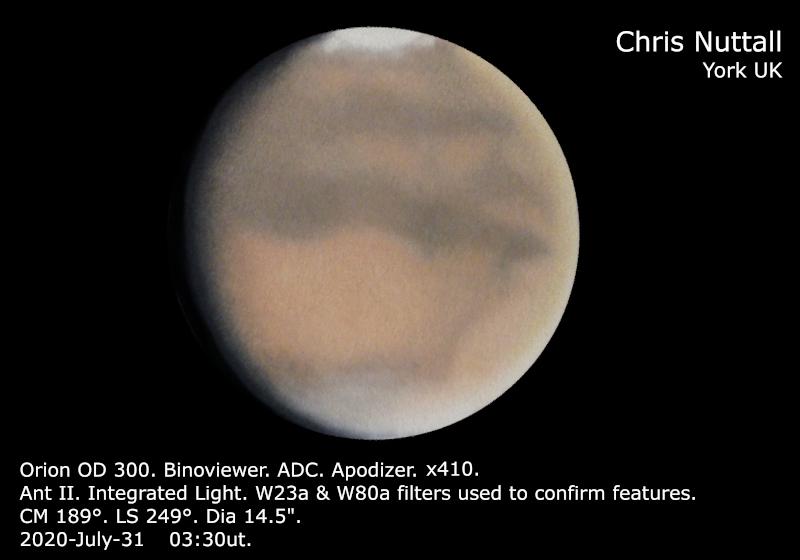
August 13th
Time to write something about the latest Mars mission, and the observational narrative will be continued in the next posting.
Today is a fortnight into the NASA Perseverance mission. This can be followed at the official website, and I am just going to mention here that the craft will deploy the Perseverance rover upon landing on 2021 February at the 49 km diameter Jezero crater. I have to admit that I had never heard of that name, and find that it is named after both a village and a municipality in Bosnia & Herzegovina. (Odd to use terrestrial place names upon Mars, when there are many past astronomers associated with the planet who haven’t been commemorated with a named feature yet…..) Its coordinates are 18o N, 282o W, though you will probably see it given as 18o N, 78o E on the NASA website. We still used degrees west for martian longitude in the BAA, and in other amateur planetary groups.
The location of Jezero is interesting, as it lies at the boundary between the Syrtis Major and Isidis Regio (Isidis Planum). Again it has been chosen for its interesting geological history, but also a near-equatorial location will be good for the year-round working of solar panels.
Wikipedia adds the following interesting information: “Thought to have once been flooded with water, the crater contains a fan-delta deposit rich in clays. The lake in the crater was present when valley networks were forming on Mars. Besides having a delta, the crater shows point bars and inverted channels. From a study of the delta and channels, it was concluded that the lake inside the crater probably formed during a period when there was continual surface runoff.
In 2007, following the discovery of its ancient lake, the crater was named for Jezero in Bosnia and Herzegovina… In several Slavic languages….. the word jezero means ‘lake’ .”
The mission has also taken with it the first Mars helicopter, which has a rotor diameter of 1.2 metres, and which will have to take off at a high r.p.m. in the thin martian air. At least one or two flights are planned; the ’copter has two cameras, one colour and one black and white.
I close by reflecting that I started my work as BAA Assistant Mars Coordinator within the former Terrestrial Planets Section forty years ago in 1980, taking over as the Coordinator in 1981, while the Viking mission was still active. There seem to have been a lot of spacecraft in the intervening years!
July 2020
July 29th
In my Interim report in the June Journal, I wrote: “The seasonal separation of Novus Mons (a.k.a. the Mitchell Mountains) from the cap is normally complete at Ls = 238 or 239o (corresponding this year to mid-July).” And here is a nice image by John Sussenbach on July 13 showing the sharp projection that the detached Novus Mons makes at the polar cap edge on its W. side, and some further images showing the same feature by Mike Hood and Gary Walker in the USA, and by Damian Peach with Chilescope. The separated feature is now rapidly shrinking and fragmenting further, and will ultimately leave behind a number of sparkling points resembling mountain peaks.
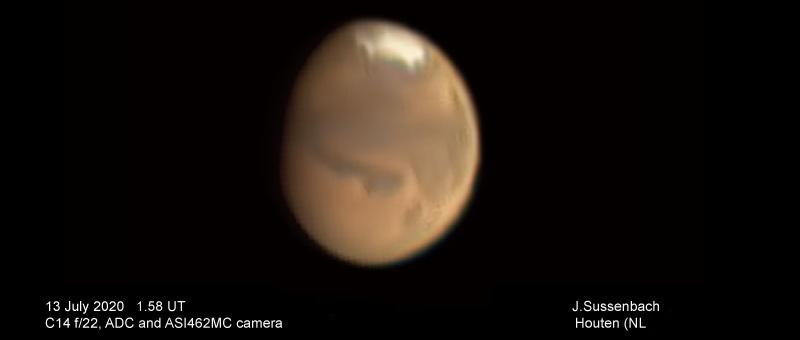
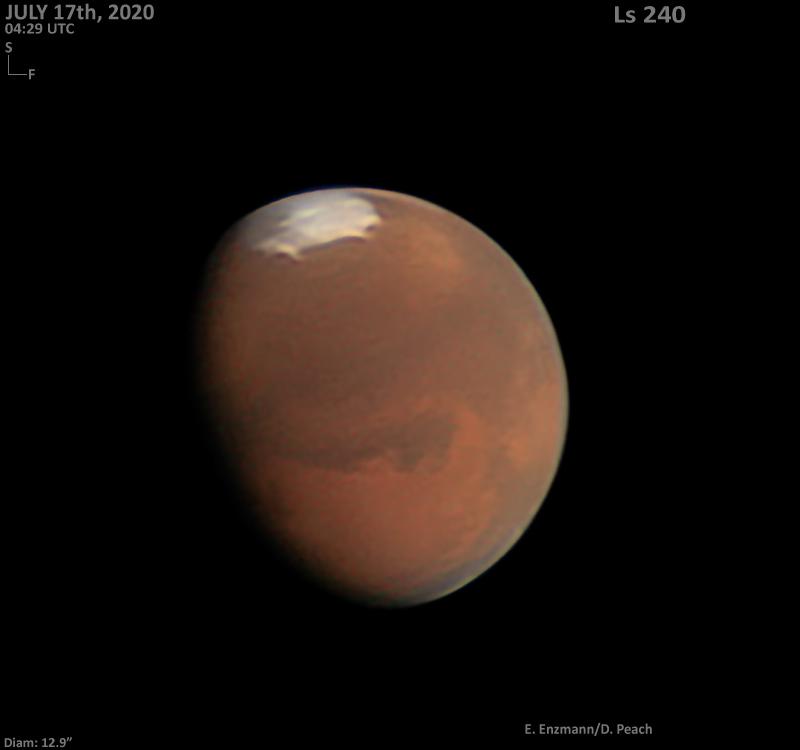
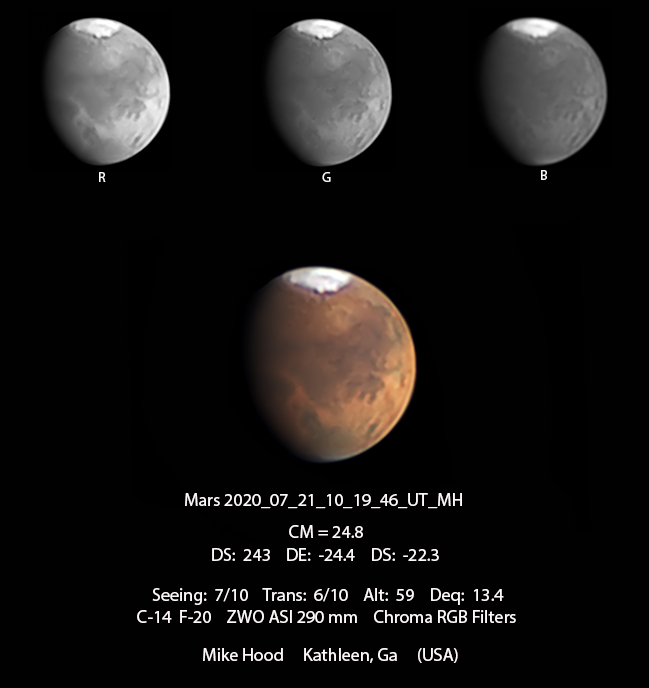
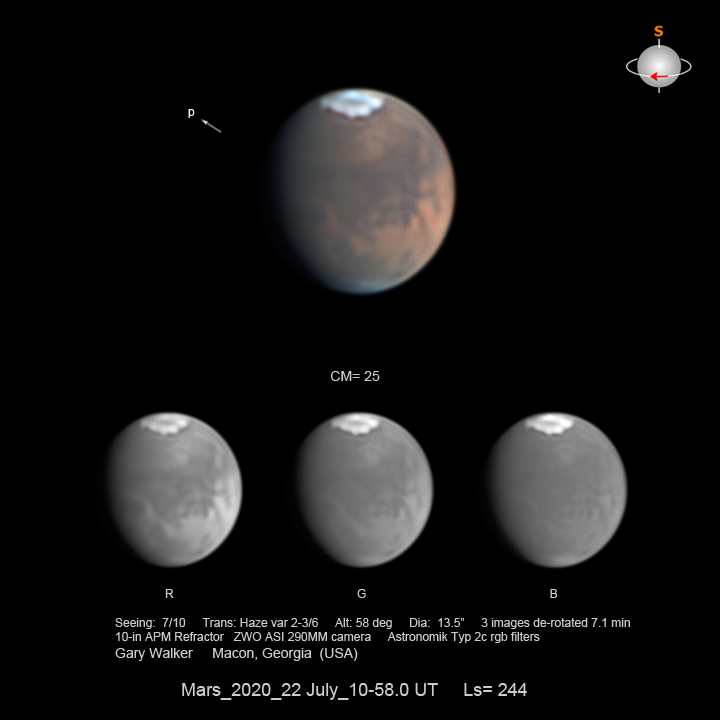
The image by Walker on July 22 strongly reminded me of the accurate (if slightly stylised) drawings made by K.Graff with the 63 cm refractor of Hamburg Observatory at the 1924 opposition, and so I have scanned his plate of SPC drawings from the original report (‘Beobachtungen und Zeichnungen des Planeten Mars während der Perihelopposition 1924’, Astronomische Abhandlungen der Hamburger Sternwarte in Bergedorf, volume 2, No. 7 (1926)) to illustrate this. Notice how Graff’s drawing of Aug 25 at CML = 005o shows the bright Novus Mons on the left and also the bright Argenteus Mons [‘Silver Mountain’] on the right.
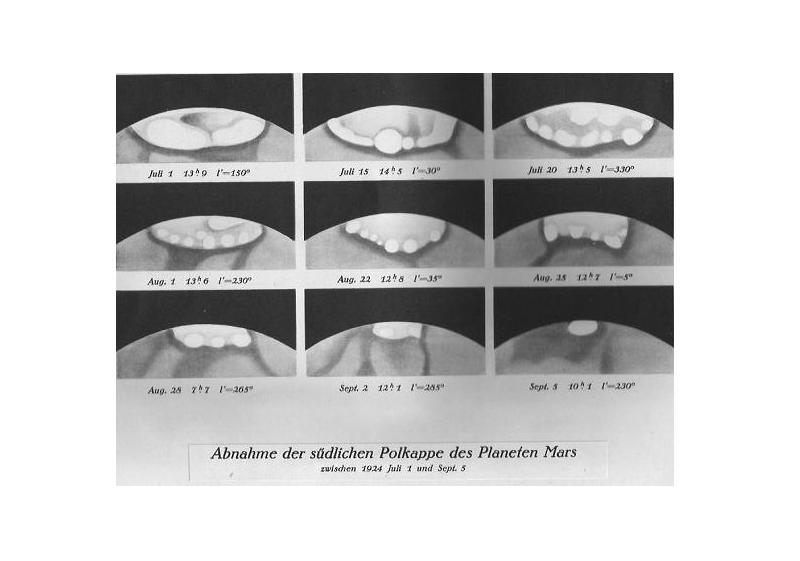
Recent visual observations have nicely proved that several persons are still increasing the contrast of their stacked images unduly. Everyone needs a consistent style of processing, so that objective and quantitative comparisons can be made from day to day. But presenting a single high contrast (perhaps a single infrared) image will give the impression that the planet is normal, when in reality surface contrast is well below normal. Two alternative versions of processing are acceptable, of course, so long as one is the result of stacking only and light (but consistently applied) processing. Makoto Adachi at the ALPO Japan website has again warned observers about this tendency to over-process when there are dust storms active or subsiding, and I can only reiterate his views, with the following reality check. Both Abel and McKim on July 11-12 observed the area recently affected by dust fallout from Noachis to Argyre, and saw contrast much reduced visually, although contrasts around the SPC were normal. Both found the brightening towards the following limb reduced, more diffuse, and somewhat yellowish. Argyre and surroundings were light, slightly yellowish, and suggestive of deposited dust. Margaritifer Sinus was very faint and even Meridiani Sinus, though obvious, was fainter than normal.
Recent images suggest that small-scale dust activity is continuing in the form of dust clouds near the edge of the polar cap.
July 11th
Since the last posting, the fairly extensive Regional dust storm has come to an end. Dust activity stretched as far east as eastern Noachis, leaving an albedo anomaly E. of Argyre, and some dust seems to have settled in Argyre itself. There also seems to be some change to the W. side of Hellespontus. It has become clear (through images that were not available at the time) that the event had started on June 22, when there was dust N. of and to the W. of Aurorae Sinus. It seems that Sinus Sabaeus and Meridiani Sinus were never really affected by this event.
Meanwhile the SPC continues to recess and to display complex internal details including bright spots upon the periphery. Some of the highest resolution images have shown a slight yellow colour, due to dust, over parts of the cap, while Peach on July 3 in excellent seeing from the UK imaged a discrete dust cloud at the very edge of the SPC. A full account of the Regional storm will be reserved for a later paper.
In this short update I am uploading images by Einaga (Japan) showing the very start of the Regional storm on June 22 and 23, some by Foster (South Africa) on July 7 illustrating the typical aspect of Solis Lacus with the dark Phasis streak closely following the Eye of Mars, one by Peach from the UK from July 3 (see earlier), and a series from June 28 by Kumamori (Japan) that includes little patches of residual dust activity along Valles Marineris and elsewhere. We must not forget those parts of the planet untouched by the storm, and in this respect I include images by new contributor Tom Williamson (USA) for July 1 and by Martin Ratcliffe (USA) for June 30.
Several more contributors from 2018 and earlier years have joined in. I would particularly like to welcome back Ed Grafton, who missed the last couple of oppositions. Our list at the top of this page now contains 43 names.
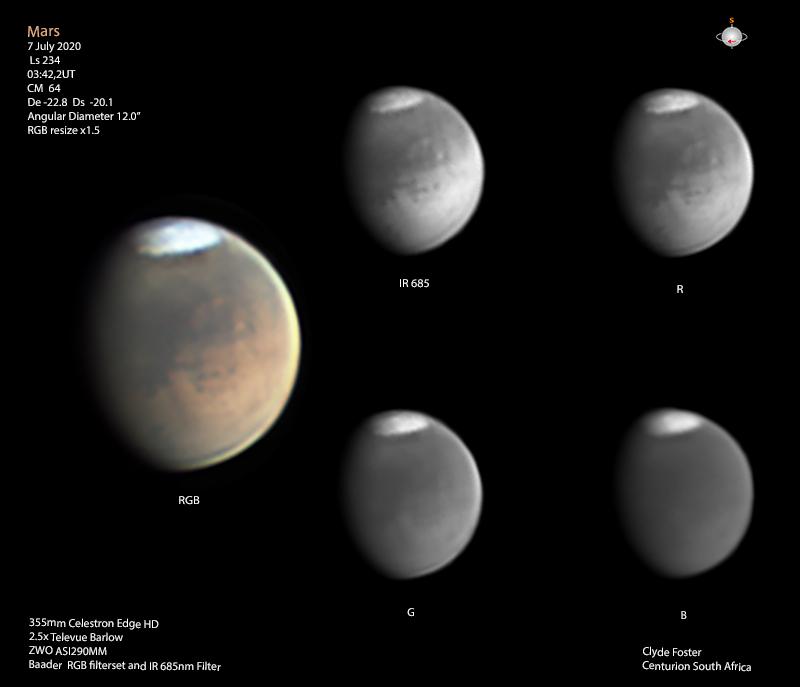
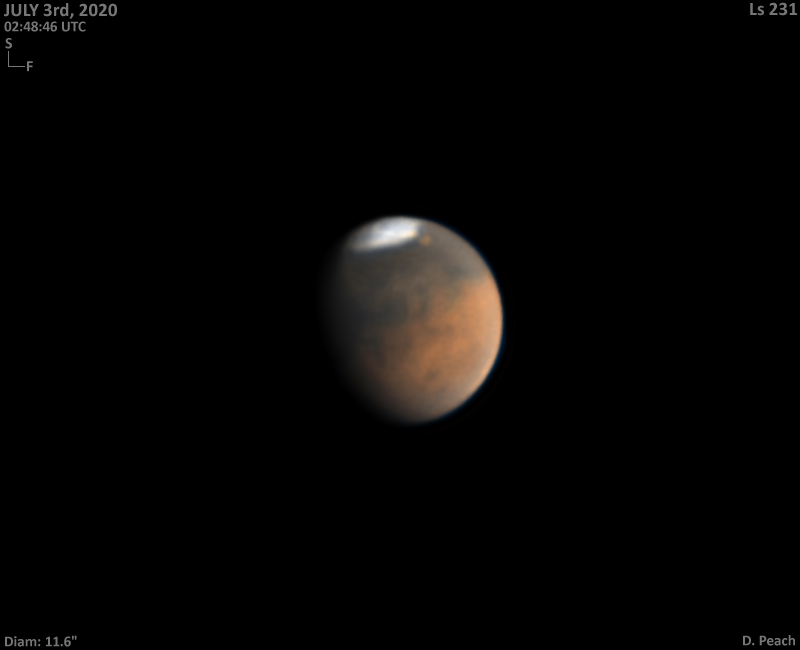
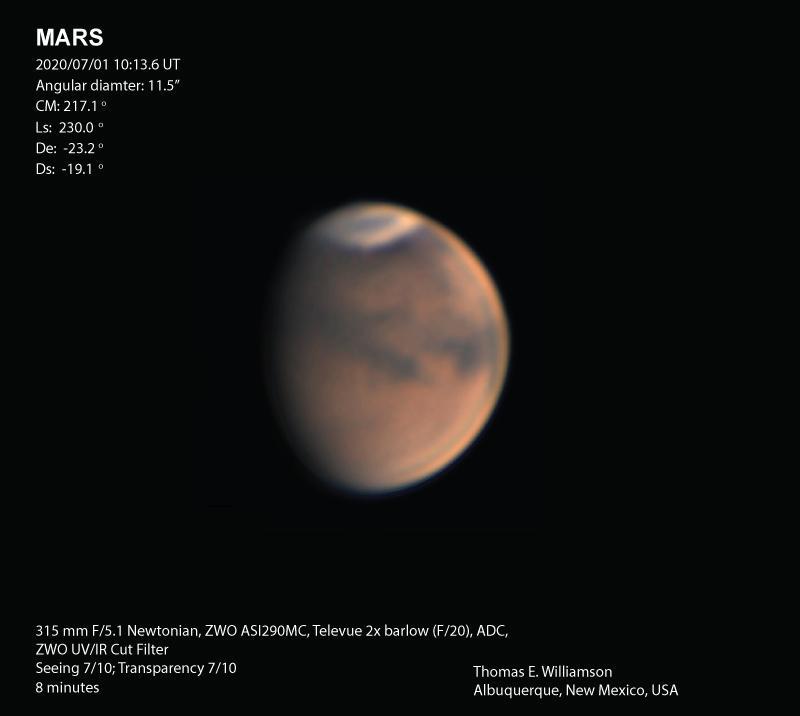
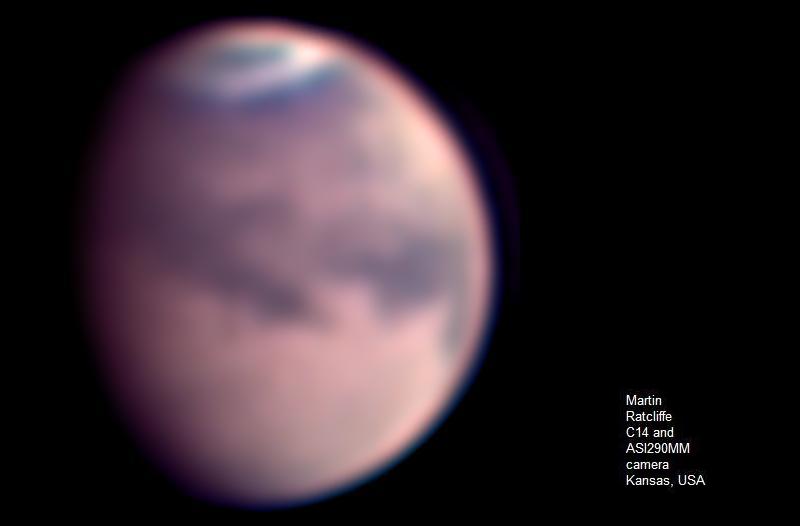
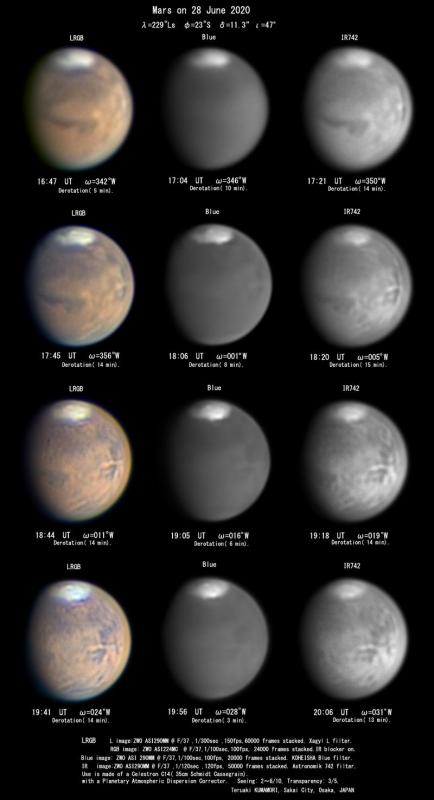
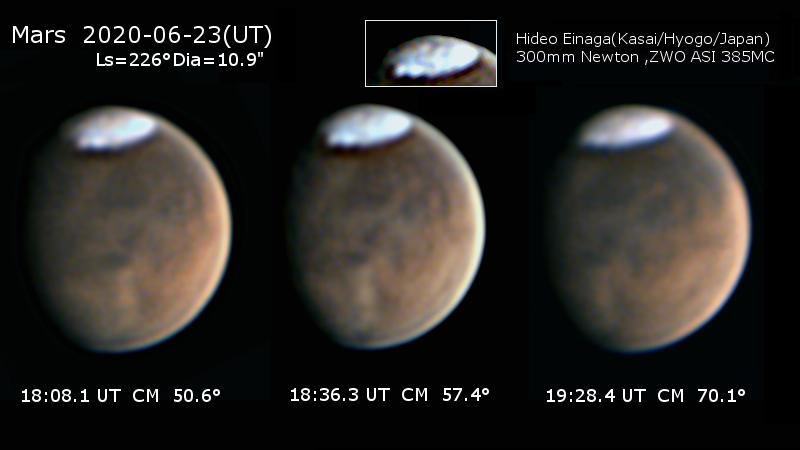
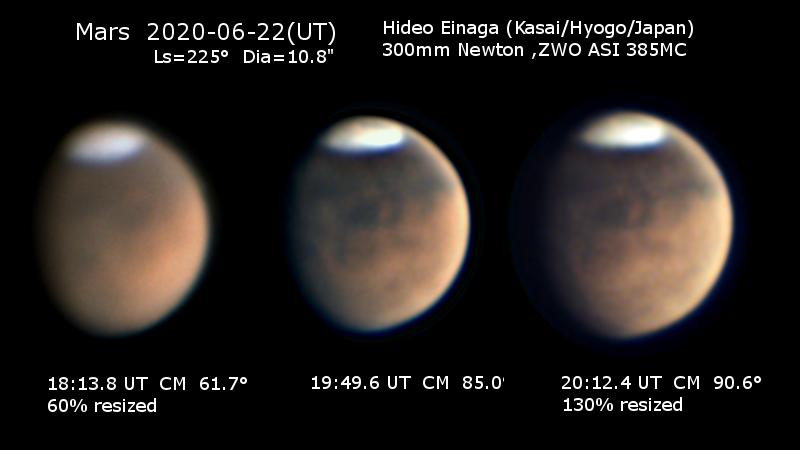
June 2020
June 26th
Since the last update there has not been much to report, and I had thought to delay this update another week or so. The polar cap slowly sublimes and reveals a complex dark interior. Routine patrol images by Foster (Jun 21), Hood (May 31) and Peach (Apr 21), together with one by a new contributor to the BAA (but experienced imager) Peter Gorczynski (Jun 23) are posted here.
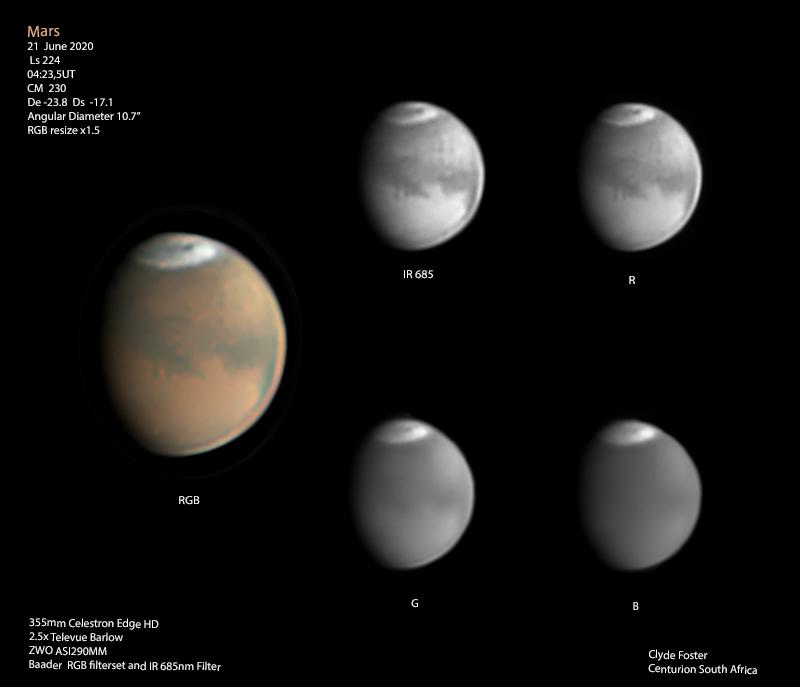
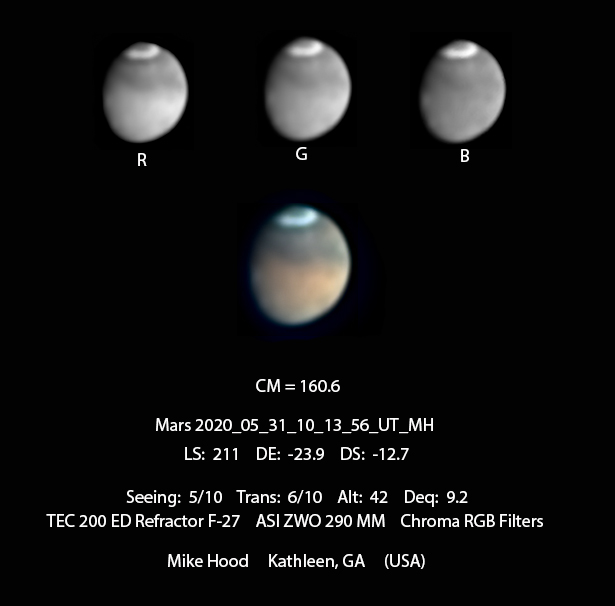
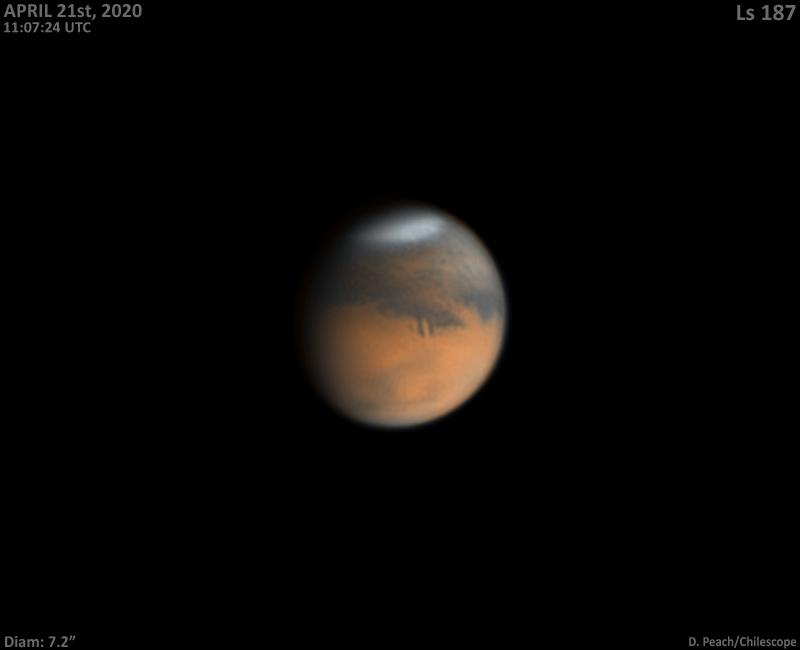
This morning I received an email from Mark Lonsdale (Australia) which stirred me into action….
Since Jun 23 there had been some sightings of dust clouds in the longitude of Chryse Planitia (telescopic NW Xanthe) that had filled this impact basin and the area to the south; there was also some dust which has spread along part of Valles Marineris. I saw one image online three days ago but was uncertain whether some small brighter patches were artefacts or not. But from June 24 onwards, more images from that and the following dates have now been posted online, confirming the activity, and this morning before breakfast I received an email with images from Dr Lonsdale taken yesterday at around 1830UT that showed a very distinctive dust cloud east of Lunae Lacus. There is also some obscuration of Margaritifer to the east and some additional terminator dust activity near the cap at high southern latitude.
I quickly posted an alert on the BAA Members Forum, emailed a few dozen selected observers who may be in a position to observe these longitudes, and finally I am posting Mark’s image here along with earlier ones from Japan by T.Kumamori and K.Yunoki (Jun 23-24) in order to show changes in the clouds and the bright streak of a dust-filled Valles Marineris. We can again see that some dust has again affected Margaritifer Sinus, rendering it fainter and less contrasty on the evening side. There is also some dust cutting across the south of Ganges. M.Adachi also saw something of this activity on Jun 23, and commented upon the lack of contrast at the longitude of the storm.
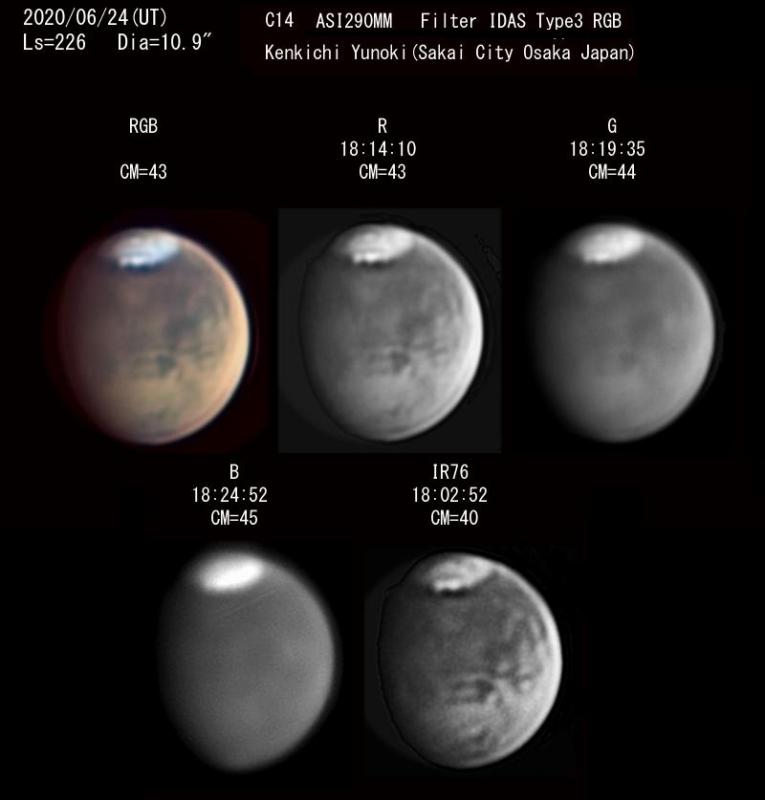
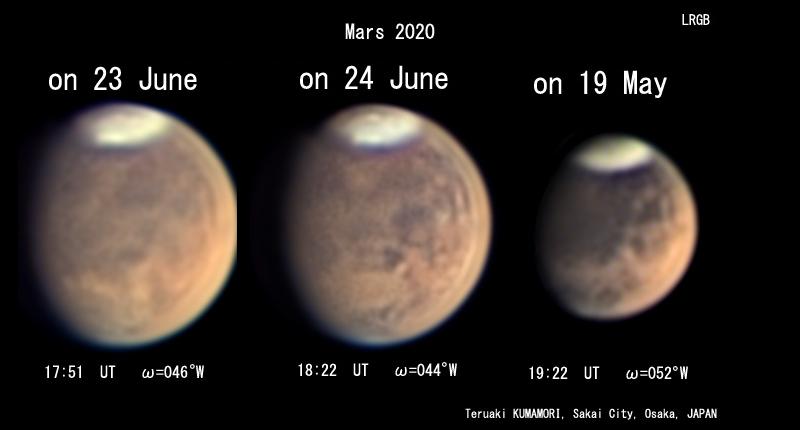
Gorczynski’s Jun 23 image shows that the Hellas basin on the opposite hemisphere had remained normal. It is not yet clear whether the activity is going to spread further. Please try to observe it, and send me your images.
Our list of active observers already stands at 34, and we are still four months before opposition.
Of the ororgaphic clouds the one at Arsia Mons has been especially prominent over the past few weeks. See Foster’s image of May 23 posted below. We have lately seen seasonal dark rifts appearing in the SPC. MacNeill’s image of May 27 (CML = 338 degrees) shows a ground-coloured curved streak near the S. pole, reminding us of a local polar storm in 2003. This streak was less apparent in images by Kumamori and Foster in subsequent days. Antoniadi’s map of the SPC is given for reference here.
In the equatorial regions we have had a small dust cloud in Chryse, during May 21-23 approximately, but which did not expand further. Arakawa’s and Kumamori’s images of May 23 (when it was most apparent) are given here.
All observations agree in showing the martian atmosphere to be quiet, and the recession of the SPC going according to schedule.
On May 30 a paper by Jim Shirley, the Director and others on the 2018 global storm in particular – and the prediction of global dust storms generally – appeared in Journal of Geophysical Research – Planets, and a pdf copy can be obtained from the Director.
A couple of dates have lately been missed in May: in April every date was covered by at least one image. As Adachi’s drawings of May 29 posted here show, the disk is now big enough for quality visual observations, so I hope even more observers will now join us.
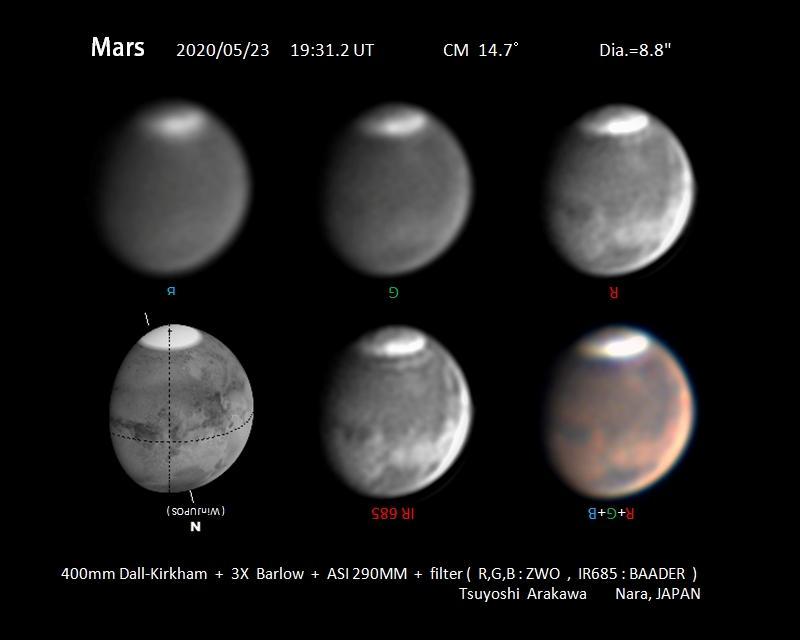
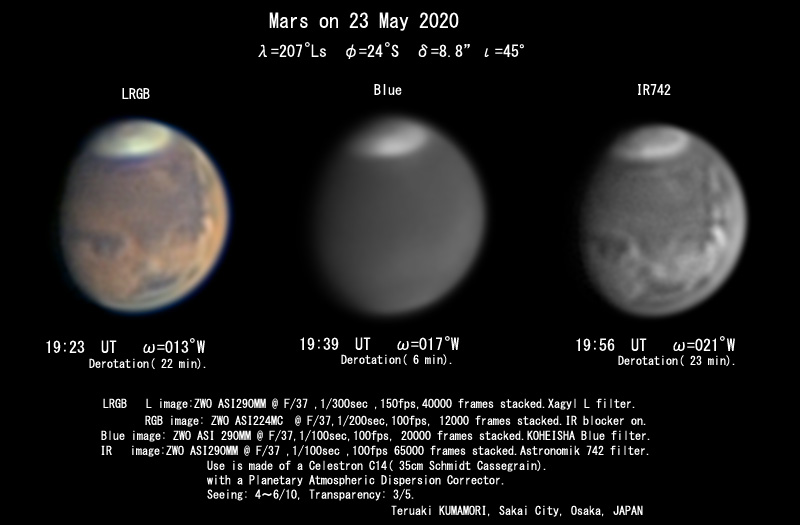
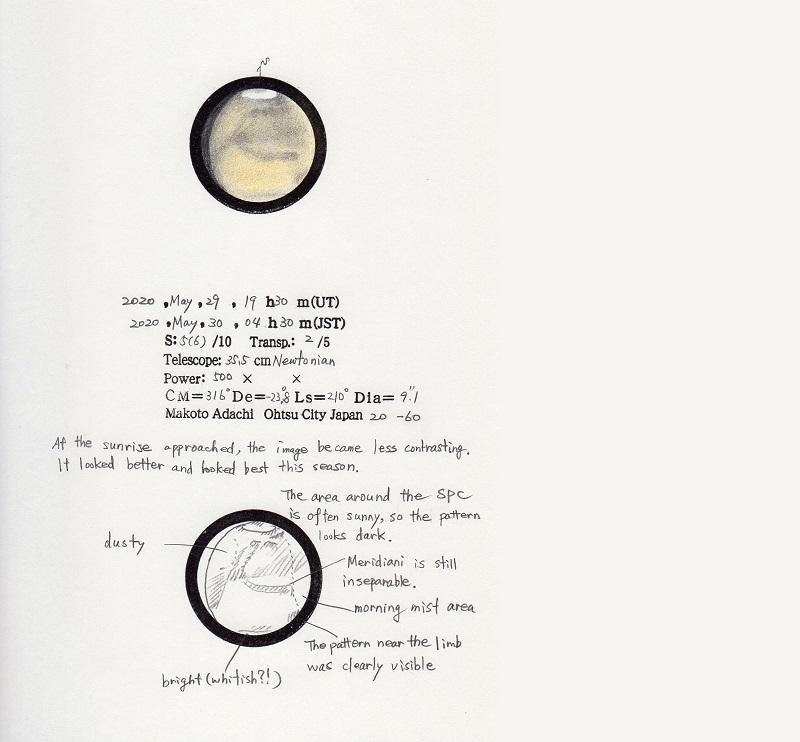
May 2020
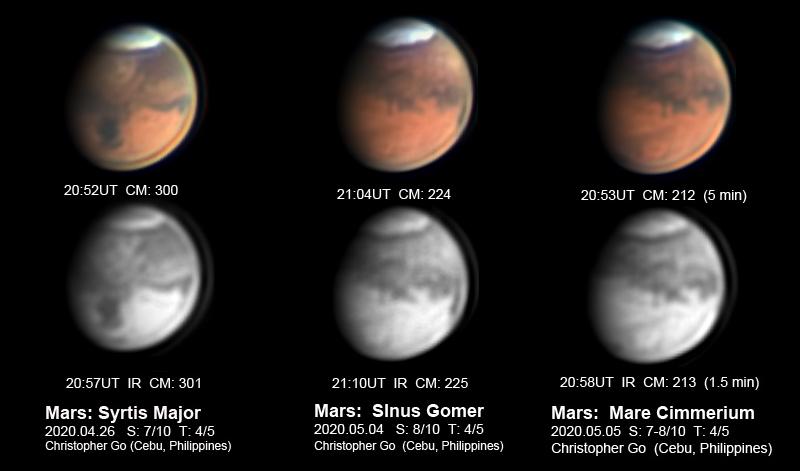
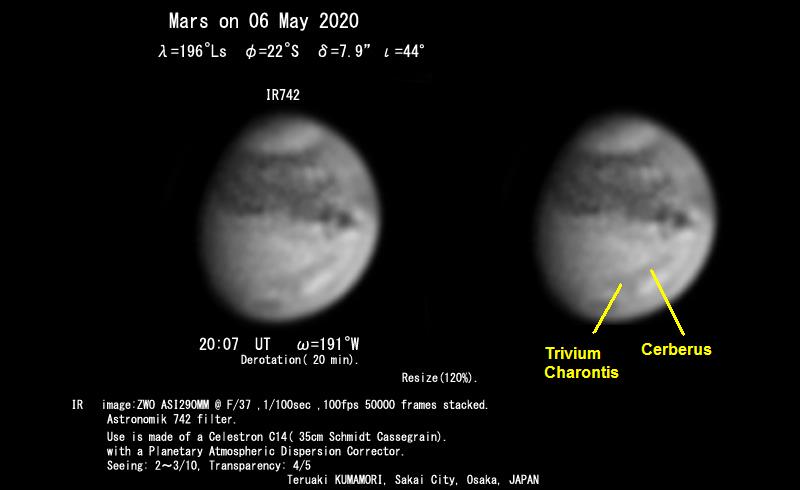
May 1
The latest news is that Margaritifer Sinus has recently returned to nearly its normal shape. This change must have been due to dust excavation having taken place as a result of the recent storm along nearby Valles Marineris and environs. This opinion about reversion is shared by ALPO (USA) Mars Recorder Roger Venable, and the return to normal is apparent in a number of images: Wesley’s for Apr 17 and Foster’s for Apr 30, for example. We post these images here. For comparison we show a high resolution Feb 26 image from Peach which best shows the peculiar shape that had been apparent since the global storm of 2018. No more dust has been seen in Valles Marineris and (for example) Kumamori’s and Wesley’s images of Apr 16 and 17 respectively show the area normal again.
Although Margaritifer is now normal, or nearly so, several other small changes as a result of the storm remain. Phasis and Indus stand out as striking examples of areas yet to revert to normal. One could find further small differences at the southern limits of Chryse-Xanthe.
We welcome several previous contributors who have begun imaging this year. A new contributor, Mark Lonsdale, brings our total number to 26. His image of Apr 27 (given here) shows that the Hellas basin is now inactive.
The degree of coverage of martian longitudes remains a little unsatisfactory, but observations were recorded every day this month, and we missed only a handful of dates since Jan 1.
I hope all Section members are healthy. I last commented upon the Covid 19 crisis a few weeks ago, and since then the consequences of the epidemic worldwide have been tragic and far-reaching. We are now officially over the peak in the UK, according to a government announcement yesterday, and can finally look forward to a (very) slow return to normality.
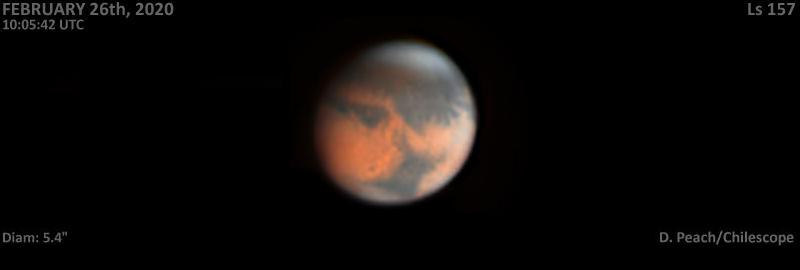
April 2020
The weak local dust activity in Hellas continued for a little while, and appears to have caused the temporary appearance of the small dark area Zea Lacus near the centre of the basin. In the latest images by Clyde Foster and Eric Sussenbach on Apr 12-14, all appears quiet and Zea Lacus is only weakly visible. In the first picture uploaded this time we show three recent images from around the martian globe. In Foster’s image Nodus Alcyonius is unusually weak, and this is evident from the other 2020 images. MacNeill’s work shows the continued existence of the orographic clouds. We now have occasional observations to hand from 18 observers, but coverage of all longitudes is still relatively poor at the present time.
A local dust storm broke out at Valles Marineris about Apr 11, commencing near the central part near Aurorae Sinus. (Images of the region by Paul Maxson had looked normal a few days previously.) Unfortunately we only have colour images to work with: separate red, green and blue filter images help to differentiate between dust and water ice clouds. There are too few good images to fully document this event, but here we give the images of MacNeill for Apr 11, 12, 13 and 14: they are very good for the tiny disk size, but in the first ones the activity is too close to the terminator to make out much detail. On Apr 11 there is surely some small patch of dust south of Aurorae Sinus, and in the better image next day this seems to run NE into southern Xanthe. Some obscuration of Mare Erythraeum is also evident, but this may have been due to dust diffused from another local event, given that Argyre also showed local activity of late. By Apr 14 some dust has expanded to the east along Valles Marineris to partly affect southern Margaritifer Sinus. However, the dust looks somewhat diffused. Meridiani Sinus remains unaffected. Drawings by Makoto Adachi for Apr 14 confirm the obscurations, as well as the normal aspect of Meridiani.
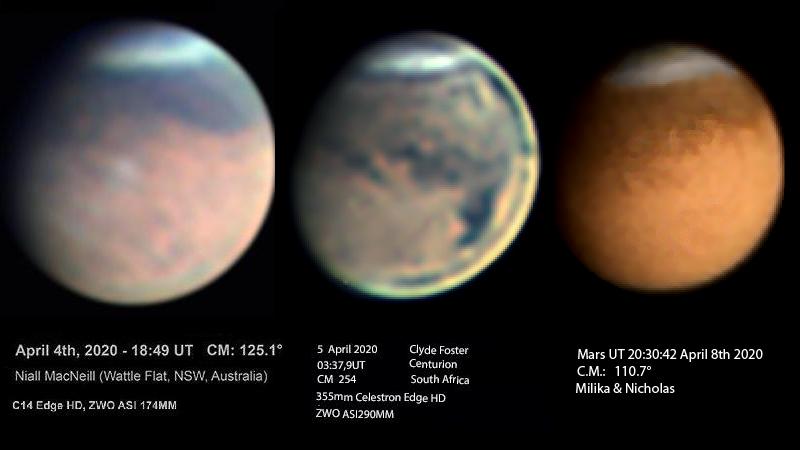
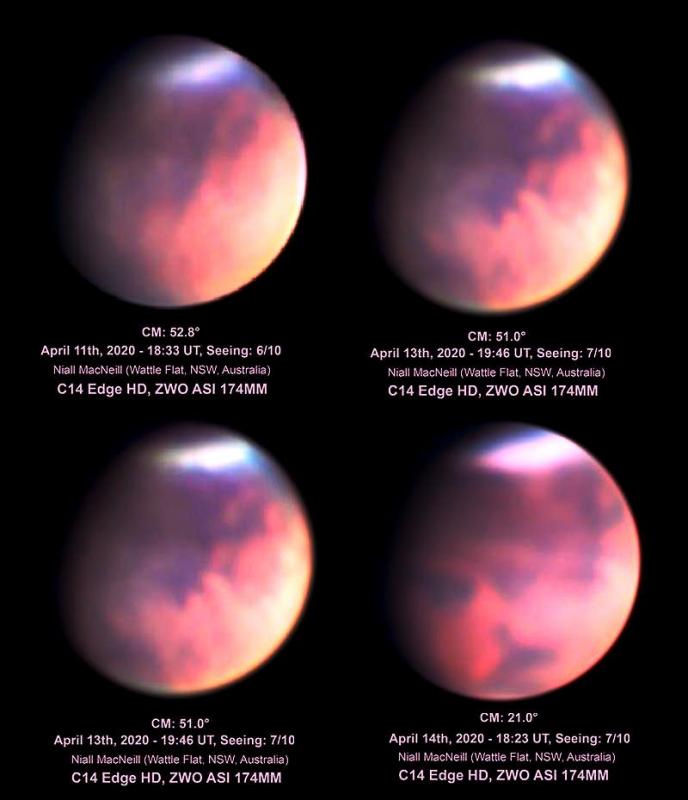
March 2020
March 31
We continue to receive at least one image or drawing per day for most days of the month: although this is hardly enough to monitor all relevant longitudes for dust outbreaks, all such observations are much appreciated.
Earlier in March there was a short-lived dust storm in Zephryia, whose start was described in the previous update and which will be discussed further in a forthcoming Interim report in the June BAA Journal. Here I have simply posted a collage of Foster’s images, and will merely add that the storm did not persist for long.
A little later, there was some local dust activity in Hellas, according to the images of Kumamori (best recorded on 23rd-25th), MacNeill (18-20th), Milika & Nicholas (17-18th) and Foster (29th), and the drawings of Adachi (25th).The south of Hellas adjacent to the south polar cap seemed to be the early focus of activity, with a tongue of polar hood protruding into the basin.
On March 25 Foster recorded the whole of the Argyre basin (another area adjacent to the polar cap) to be bright and yellow compared to the adjacent days: this was another (and also short-lived) local dust storm: I have not uploaded the image. Such storms at the edge of the newly exposed polar cap are well known; southern spring (Ls = 180) begins in the second week of April, so we may expect more of these events.
We must not leave out other longitudes, and the image by Peach on March 11 shows fine details within Mare Cimmerium and Mare Tyrrhenum in the southern hemisphere. The Aetheria development on the following side of Elysium looks weak in this image. Finally, an image by Morales from February 18 shows how tiny Mars is compared to the Moon: he has greatly enlarged the disk of the Red Planet in the inset.
My March Sky Notes prepared for our cancelled BAA Ordinary Meeting are now online at the BAA’s YouTube channel. I mention Mars, and show some work done at the seasonally comparable opposition of 1941. The audio tape was recorded without preparation in a great hurry in the one and only ‘take’, so that it could be uploaded in time, and I hope I shall be forgiven for any hesitation, repetition or deviation.
With the worldwide coronavirus pandemic worsening daily, with some 800,000 cases as I upload these files, I do hope that all our contributors are safe and well, but at the same time I would like to add that every observation made under these circumstances will be vital for a successful survey at this highly favourable opposition.
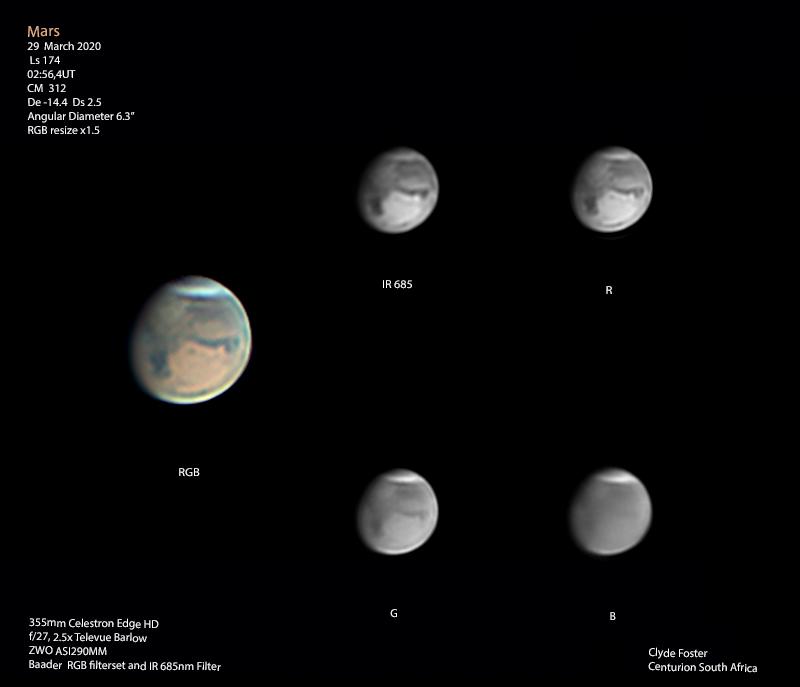
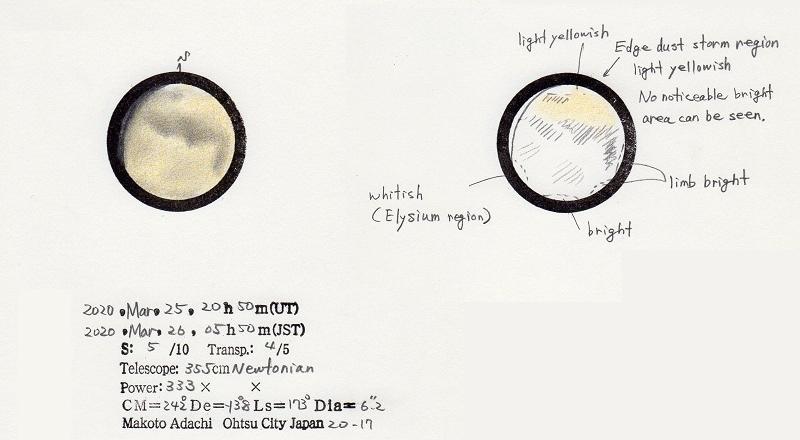
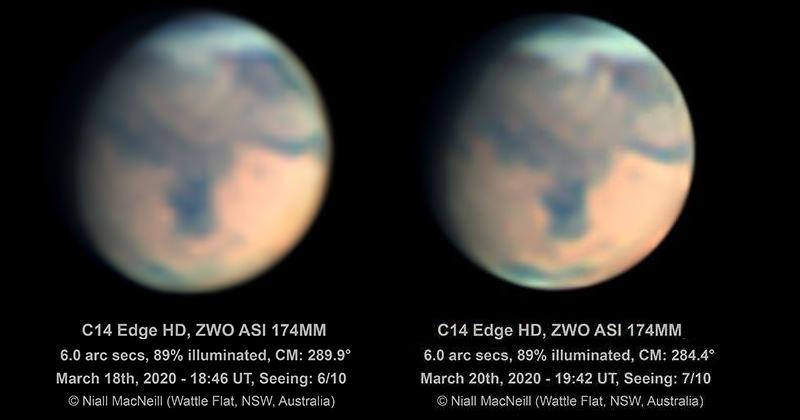
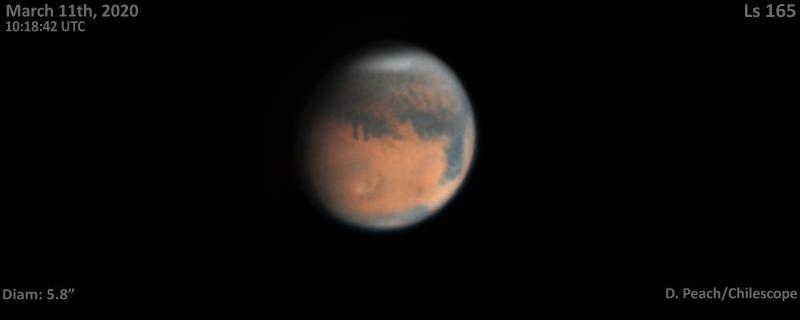
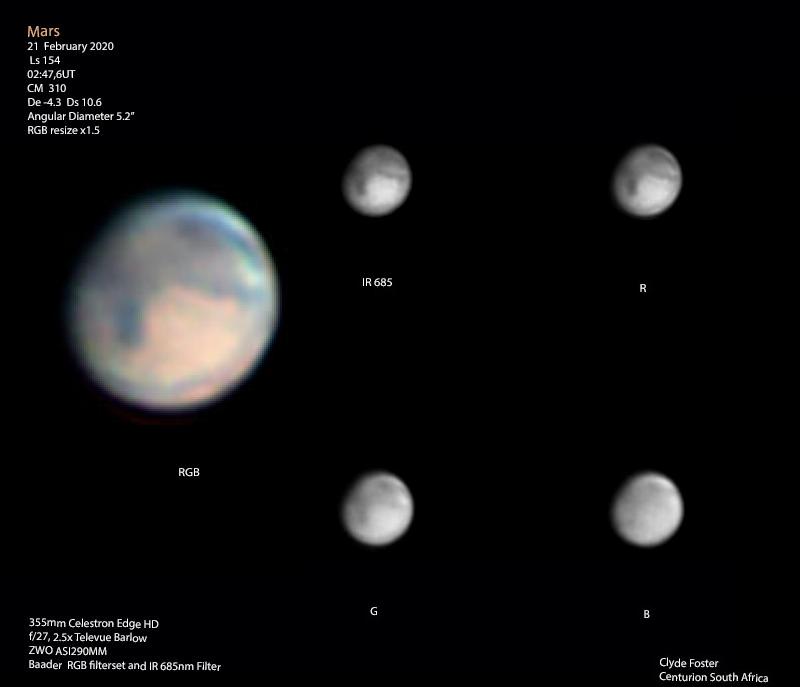
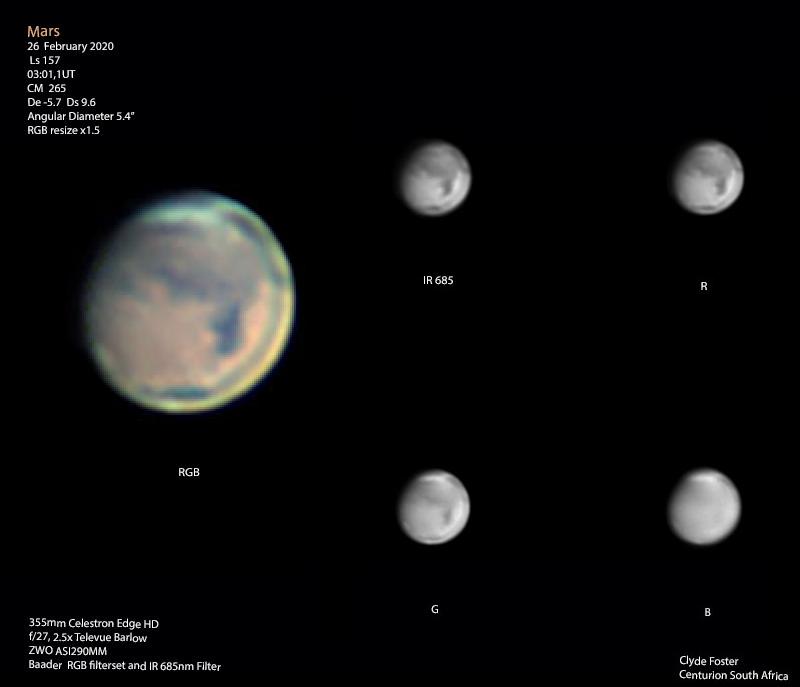
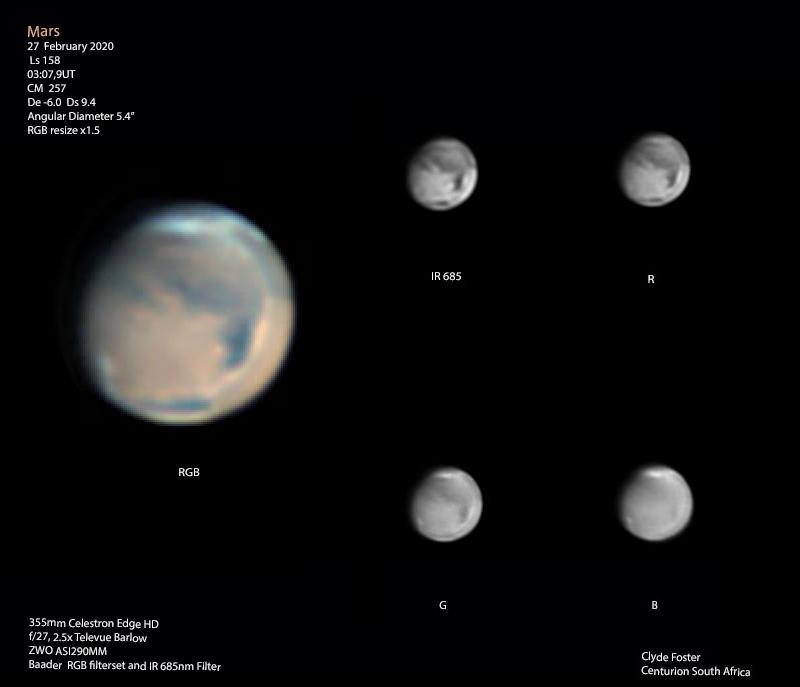
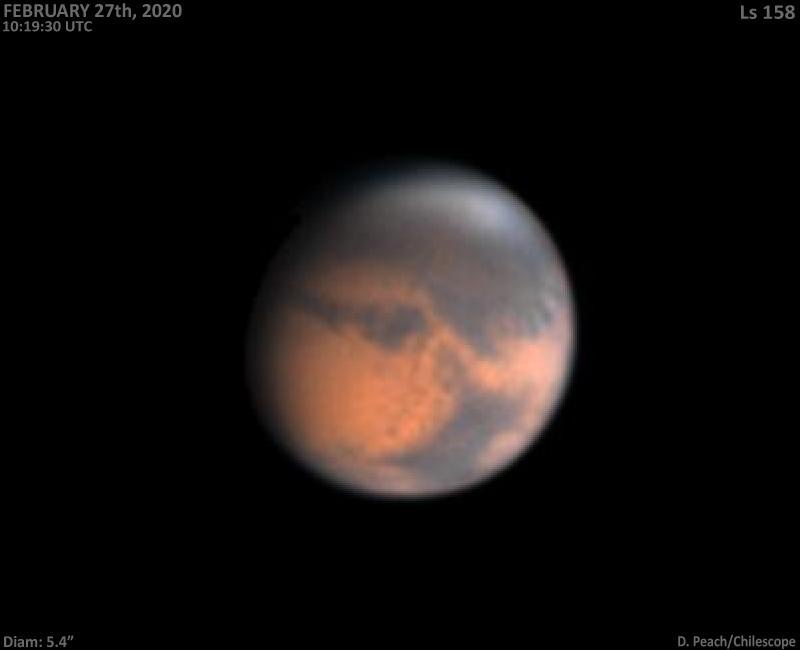
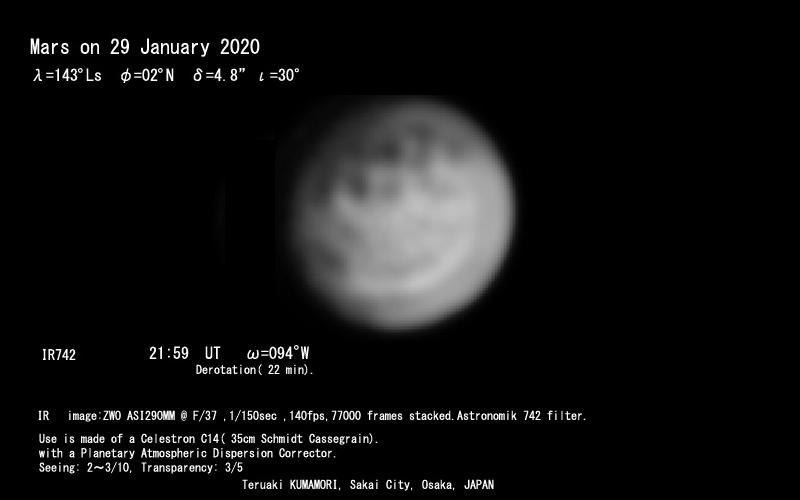
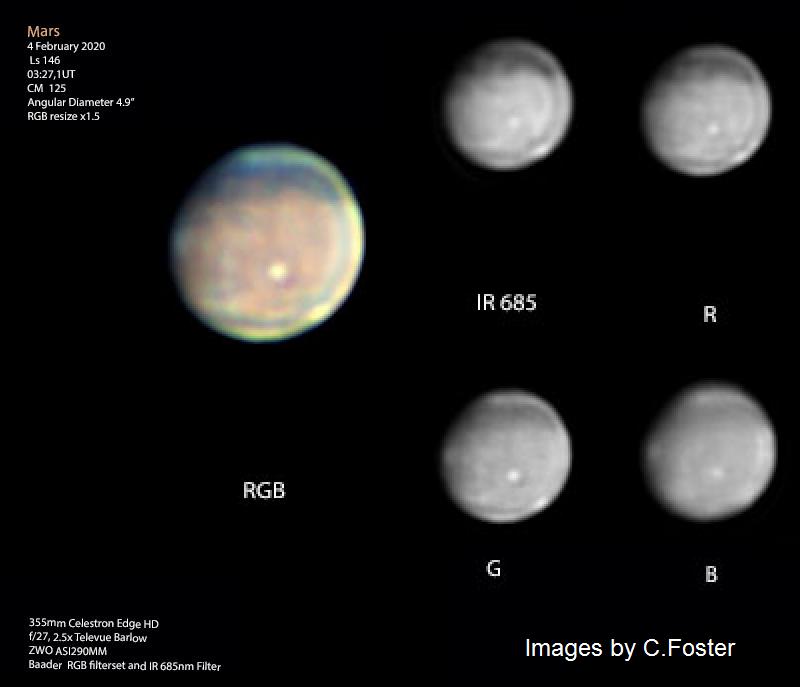
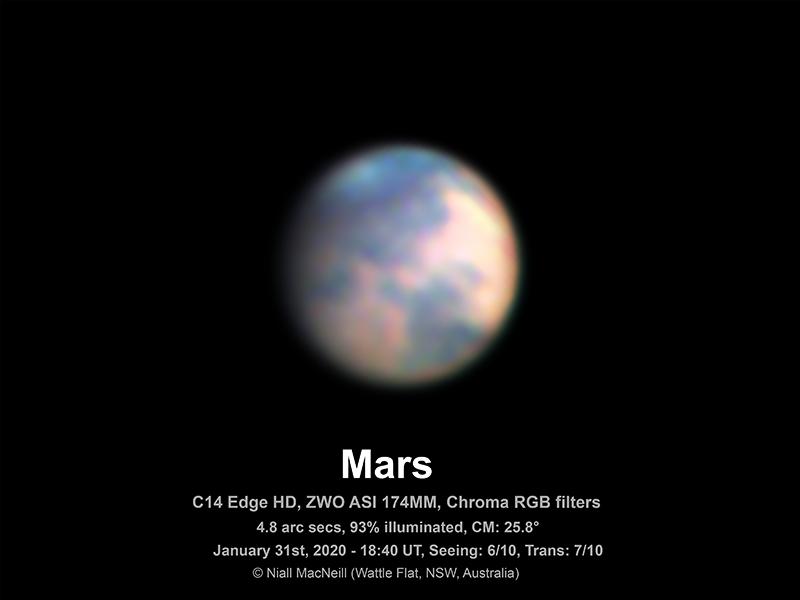
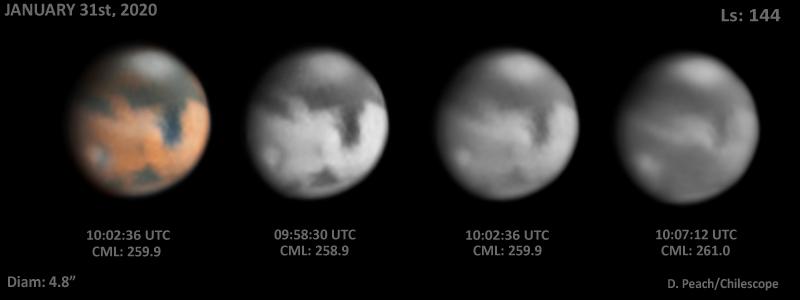
January 2020
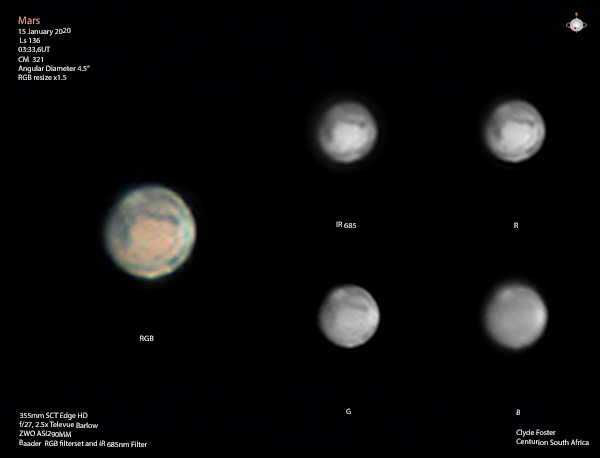
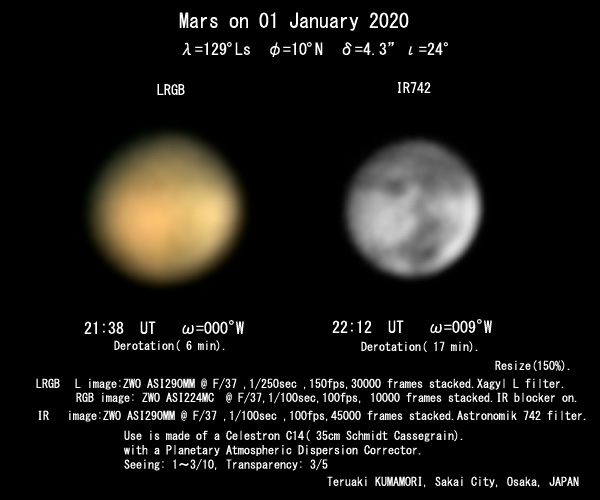
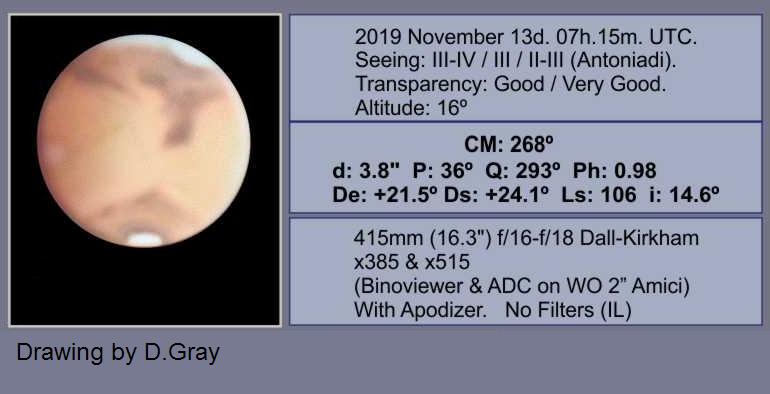
Opposition will be on October 13, which is a long way off! The disk diameter then will be a little greater than 22 arcseconds. Already a few members are making early observations, the earliest being from last October. I shall be posting some of these in my next entry in a day or two’s time.
Richard McKim, Director
https://britastro.org/wp-content/uploads/2019/11/2020-04-27-ML.JPG
https://britastro.org/wp-content/uploads/2019/11/2020-04-17-AW-2020-04-30-CF.JPG
https://britastro.org/wp-content/uploads/2019/11/2020-05-04-MN.JPG
https://britastro.org/wp-content/uploads/2019/11/2020-05-23-CF.JPG
https://britastro.org/wp-content/uploads/2019/11/Antoniadi-SPC.JPG
https://britastro.org/wp-content/uploads/2019/11/2020-06-25-ML.JPG
https://britastro.org/wp-content/uploads/2020/03/2020-03-08-to-2020-03-10-CF_0.JPG
https://britastro.org/wp-content/uploads/2019/11/2020-02-18-EMr.JPG
https://britastro.org/wp-content/uploads/2019/11/2020-03-08-to-2020-03-10-CF_0.JPG
https://britastro.org/wp-content/uploads/2019/11/2020-03-17-and-2020-03-18-MN.JPG
https://britastro.org/wp-content/uploads/2019/11/2020-08-07-to-2020-08-14-EG.JPG
https://britastro.org/wp-content/uploads/2019/11/2020-08-25-FJM.JPG
https://britastro.org/wp-content/uploads/2019/11/2020-06-23-PG.JPG
https://britastro.org/wp-content/uploads/2017/08/2020-01-10-AW.JPG
| The British Astronomical Association supports amateur astronomers around the UK and the rest of the world. Find out more about the BAA or join us. |
